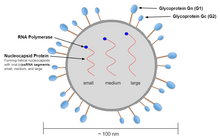| Andes orthohantavirus | |
|---|---|

| |
| Virus classification | |
| (unranked): | Virus |
| Realm: | Riboviria |
| Kingdom: | Orthornavirae |
| Phylum: | Negarnaviricota |
| Class: | Ellioviricetes |
| Order: | Bunyavirales |
| Family: | Hantaviridae |
| Genus: | Orthohantavirus |
| Species: | Andes orthohantavirus
|
| Synonyms[1] | |
| |
Andes orthohantavirus (ANDV), a species of Orthohantavirus, is a major causative agent of hantavirus cardiopulmonary syndrome (HCPS) and hantavirus pulmonary syndrome (HPS) in South America.[2] It is named for the Andes mountains of Chile and Argentina, where it was first discovered. Originating in the reservoir of rodents, Andes orthohantavirus is easily transmitted to humans who come into contact with infected rodents or their fecal droppings.[2][3][4] However, infected rodents do not appear ill, so there is no readily apparent indicator to determine whether the rodent is infected or not. Additionally, Andes orthohantavirus, specifically, is the only hantavirus that can be spread by human to human contact via bodily fluids or long-term contact from one infected individual to a healthy person.[3][4]
- ^ Briese T, et al. (15 June 2015). "Implementation of non-Latinized binomial species names in the family Bunyaviridae" (PDF). International Committee on Taxonomy of Viruses (ICTV). Retrieved 8 March 2019.
- ^ a b "Hantavirus | virus". Encyclopædia Britannica. Retrieved 2019-03-07.
- ^ a b "Andes Virus - an overview | ScienceDirect Topics". www.sciencedirect.com. Retrieved 2019-03-07.
- ^ a b "Fact Sheet about Andes Virus | Hantavirus | DHCPP | CDC". www.cdc.gov. 2019-02-20. Retrieved 2019-03-05.